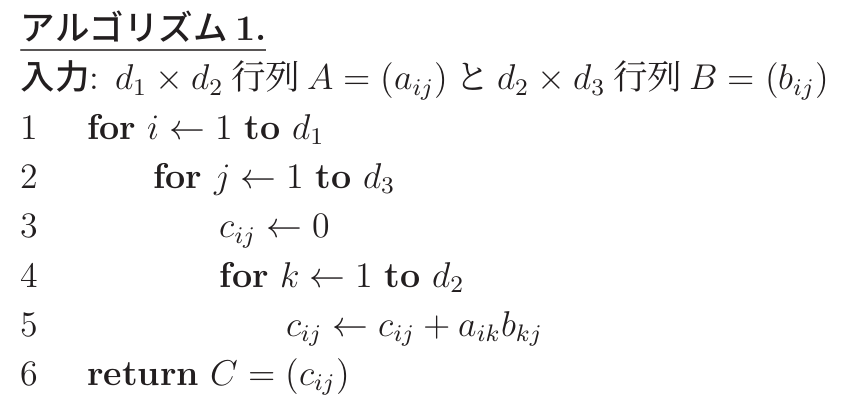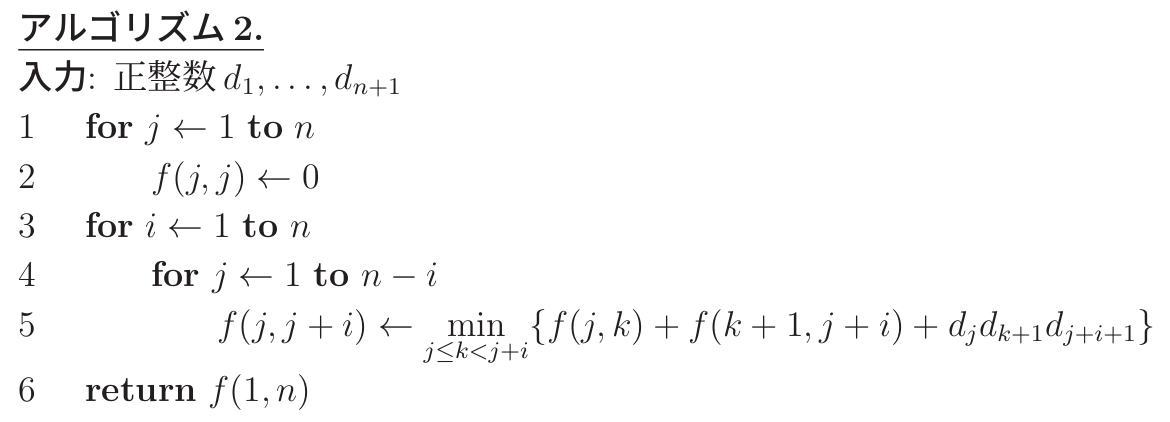九州大学 システム情報科学府 情報理工学専攻 2021年度 アルゴリズム・プログラミング
Author
祭音Myyura
Description
【問 1】
2つの数の加算,乗算および大小比較は各々単位時間で行えるものとする.以下の各問いに答えよ.
(1) 与えられた \(d_1 \times d_2\) 行列 \(A\) と \(d_2 \times d_3\) 行列 \(B\) に対し,アルゴリズム 1 はそれらの積 \(C = AB\) を求める.アルゴリズム 1 の時間計算量を答えよ.

(2) \(10 \times 100\) 行列 \(A\) と \(100 \times 1\) 行列 \(B\) と \(1 \times 100\) 行列 \(C\) と \(100 \times 10\) 行列 \(D\) が与えられたとき,積 \(E = ABCD\) をアルゴリズム1をサブルーチンとして用いて求めたい.
- (a) 数式 \(E = A(BC)D\) で表される積の順に従う場合,行列 \(E\) の計算における加算と乗算の回数の合計を答えよ.
- (b) \(E\) の計算にかかる時間が最小となる積の順を,問 (a) に倣った数式で記述せよ.また,その積の順に従う \(E\) の計算における加算と乗算の回数の合計を答えよ.
(3) \(M_i, (i = 1, \ldots, n)\) は \(d_i \times d_{i+1}\) 行列とし,積 \(X = M_1 \cdots M_n\) をアルゴリズム 1 を用いて求めたい.積 \(X\) の計算について,すべての積の順の中で最小の時間計算量をアルゴリズム 2 が与えることを証明せよ.またアルゴリズム 2 の時間計算量を答えよ.

【問 2】
図 1 は Python 言語で書かれたマージソートのプログラムである.図 1 の 32 行目で下記の入力が与えられている.次の問いに答えよ.
32: list_input = [8, 3, 6, 5, 2, 7, 4, 1]
(1) merge_sort は,リスト result の要素を start から end の範囲で昇順に並び替える関数である.空欄(A)-(G)を埋め,関数merge sortを完成せよ.
(2) sort は,リスト list_input の要素を昇順に並び替える関数である.関数 sort が呼び出されて完了するまでに,関数 merge が呼び出される回数を答えよ.また,関数 merge に与えられる実引数のリスト copy と result の要素を関数 merge の呼び出しごとに答えよ.
(3) 8 行目から 11 行目の文を削除した場合を想定する.関数 sort が呼び出された時,リスト list_input の要素は,昇順に並び替えられているか否かを答えよ.また,関数 sort が実行完了するまでに,関数 merge_sort が呼び出される回数を答えよ.
(4) 関数 sort を,リスト list_input を降順に並び替えるように変更したい.行番号を示しながら,変更すべき式と,その内容を記せ.
図1 (Figure 1)
Kai
【問 1】
(1)
\(O(d_1 \cdot d_2 \cdot d_3)\)
(2)
(a)
\((100000 + 10000 + 1000) \times 2 = 240000\)
(b)
\((1000 + 1000 + 100) \times 2 = 4200\)
\(E = (AB)(CD)\)
(3)
Statement A: Suppose that an optimal parenthesization (order of multipications) of \(M_i M_{i+1} \cdots M_j, (1 \le i < j \le n)\) splits the product between \(M_k\) and \(M_{k+1}\). Then the parenthesization of the "left" subchain \(M_i M_{i+1} \cdots M_k\) within this optimal parenthesization of \(M_i M_{i+1} \cdots M_j\) is also an optimal parenthesization of \(M_i M_{i+1} \cdots M_k\).
Statement A can be proved by contradicition. Assume that there exits a less costly way to parenthesize \(M_i M_{i+1} \cdots M_k\), then, substituting that parenthesization in the optimal parenthesization of \(M_i M_{i+1} \cdots M_j\) would produce another parenthesization of \(M_i M_{i+1} \cdots M_j\) of a lower cost than the optimum, which is a contradiction.
Similar for the "right" subchain, it is also an optimal parenthesization of \(A_{k+1} A_{k+2} \cdots A_j\).
Therefore, let \(f(i, j)\) be the minimum number of multiplications needed to compute the matrix \(A_{i\ldots j} = A_i A_{i+1} \cdots A_{j}\). By statement A, we assume that an optimal parenthesization splits the product \(A_i A_{i+1} \cdots A_{j}\) between \(A_k\) and \(A_{k+1}\). Then, \(f(i, j)\) is equal to the minimum cost for computing the subproducts \(A_{i\ldots k}\) and \(A_{k+1\ldots j}\) plus the cost of multiplying these two matrices, i.e.,
Since there are only \(j - i\) possible values for \(k\), namely \(k = i, i+1, \ldots, j-1\). Hence we have
Thus the correctness of algorithm 2 is proved.
The time complexity of algorithm 2 is \(O(n^3)\).
【問 2】
(1)
- (A): start
- (B): mid - 1
- (C): mid
- (D): end
- (E): start
- (F): end
- (G): mid
(2)
4 time
(3)
(Confused, since the program may never stop running when start=1 and end=2.)
(4)
- line 9: if result[start] < result[end]:
- line 24: if j > end or (i < mid and copy[i] > copy[j]):